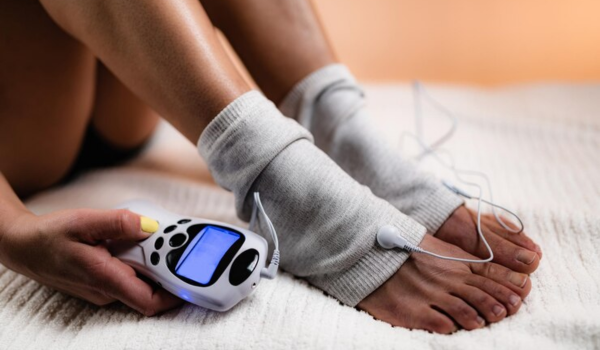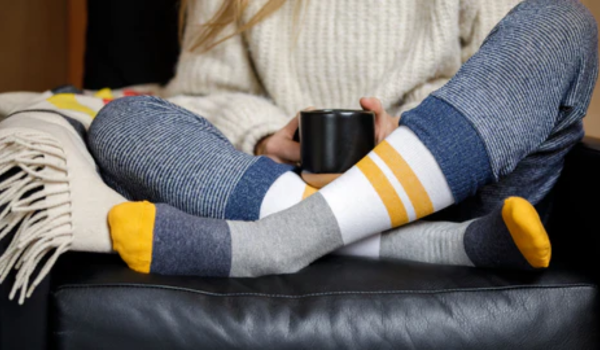The Best Compression Socks for Diabetics | Comfort & Support
The Best Compression Socks for Diabetics: A Comprehensive Guide

Diabetes can lead to various complications, particularly affecting the feet and legs due to poor circulation and nerve damage. One effective non-invasive solution is wearing compression socks.
These specialized garments apply graduated pressure to the lower legs, promoting blood flow and reducing symptoms associated with diabetic neuropathy and peripheral artery disease.
In this comprehensive guide, we’ll delve into the benefits of compression socks for diabetics, how to choose the right pair, and highlight some top-rated options available in the market.
Understanding the Importance of Foot Care in Diabetes
Diabetes can impair circulation and nerve function, leading to increased risk of foot ulcers, infections, and other complications. Proper foot care is essential for individuals with diabetes to prevent these issues.
Key Foot Health Concerns for Diabetics
- Poor Circulation: Reduced blood flow can hinder the delivery of oxygen and nutrients to foot tissues, impairing healing and increasing infection risk.
- Neuropathy: Nerve damage may lead to loss of sensation in the feet, making it difficult to detect injuries or infections.
- Swelling (Edema): Fluid accumulation in the feet and ankles can cause discomfort and exacerbate other foot problems.
Compression socks can play a pivotal role in managing these concerns by improving circulation, reducing swelling, and providing support to the feet and legs.
How Compression Socks Benefit Diabetic Foot Health?
Compression socks offer several advantages for individuals with diabetes:
1. Enhanced Circulation
Graduated compression socks apply varying levels of pressure, highest at the ankle and gradually decreasing upwards.
This design helps promote blood flow back to the heart, counteracting the effects of poor circulation common in diabetics. Improved circulation can aid in the prevention of ulcers and enhance wound healing.
2. Reduction of Swelling
Diabetic individuals often experience edema due to fluid retention. Compression socks assist in reducing swelling by encouraging the movement of fluid from the lower extremities back into the bloodstream. This can alleviate discomfort and prevent further complications.
3. Prevention of Diabetic Neuropathy Complications
While compression socks do not cure neuropathy, they can provide support and reduce symptoms such as tingling or numbness.
By improving circulation and providing gentle pressure, they may help in managing discomfort associated with nerve damage.
4. Protection Against Foot Injuries
Compression socks often feature seamless designs and cushioned soles, reducing friction and the risk of blisters or sores.
This is particularly beneficial for individuals with reduced sensation in their feet, as they may not notice injuries immediately.
Choosing the Right Compression Socks for Diabetics
When selecting compression socks, consider the following factors:
Compression Level (mmHg)
The pressure exerted by compression socks is measured in millimeters of mercury (mmHg). For diabetics, the recommended compression levels are:
- 8–15 mmHg: Light compression, suitable for mild swelling and fatigue.
- 15–20 mmHg: Moderate compression, often recommended for managing edema and improving circulation.
- 20–30 mmHg: Firm compression, typically used for more severe symptoms or post-surgical recovery.
It’s essential to consult with a healthcare professional to determine the appropriate compression level for your specific needs.
Material and Comfort
- Opt for socks made from breathable, moisture-wicking materials to keep feet dry and reduce the risk of fungal infections.
- Cotton blends, bamboo, and merino wool are excellent choices. Additionally, ensure the socks have a seamless design to minimize irritation.
Fit and Sizing
- Proper fit is crucial for the effectiveness of compression socks. Ill-fitting socks can cause discomfort or even exacerbate circulation problems.
- Measure your ankle and calf circumference to select the correct size.
Top Compression Socks for Diabetics
Based on expert reviews and customer feedback, here are some top-rated compression socks suitable for diabetics:
1. Sigvaris Eversoft Diabetic Compression Socks
Sigvaris is renowned for its high-quality compression wear. The Eversoft Diabetic Compression Socks offer:
- Compression Level: 8–15 mmHg
- Features: Non-binding top band, padded soles, and moisture-wicking fabric.
- Benefits: Enhances circulation and provides comfort without restricting blood flow.
2. Juzo Silver Sole Diabetic Compression Socks
Juzo’s Silver Sole socks incorporate silver fibers to combat bacteria and fungi, making them ideal for diabetics prone to infections. They offer:
- Compression Level: 12–16 mmHg
- Features: Cushioned sole, seamless toe, and antimicrobial properties.
- Benefits: Reduces odor and the risk of infections while improving circulation.
3. Dr. Comfort Diabetic Compression Socks
Designed specifically for diabetics, Dr. Comfort socks provide:
- Compression Level: 15–20 mmHg
- Features: Bamboo charcoal fibers, seamless construction, and non-binding top band.
- Benefits: Keeps feet dry, reduces swelling, and prevents irritation.
4. Sockwell Women’s Elevation Firm Graduated Compression Socks
Sockwell combines style with functionality in their Elevation line:
- Compression Level: 20–30 mmHg
- Features: Merino wool and bamboo rayon blend, arch support, seamless toe closure
- Benefits: Designed for those with diabetes and poor circulation, these socks offer strong support while maintaining natural moisture control and odor resistance. They’re also incredibly stylish and ideal for everyday use.

Compression Socks vs. Diabetic Socks: What’s the Difference?
It’s important to distinguish between compression socks and diabetic socks, as they serve slightly different purposes.
Diabetic Socks:
- Designed to protect feet from moisture, ulcers, and blisters.
- Usually non-binding and loose-fitting to avoid restricting blood flow.
- Feature moisture-wicking and antimicrobial materials.
- Primarily focused on comfort and prevention of foot complications.
Compression Socks:
- Designed to improve circulation by applying graduated pressure to the leg.
- Help reduce swelling, pain, and fatigue.
- Can be used by diabetics with proper medical guidance.
- May include some of the same features as diabetic socks but with added medical benefits.
💡 Best for Diabetics: Compression socks specifically designed for diabetics combine the best of both gentle compression without tight top bands, seamless design, and moisture control.
How to Integrate Compression Socks Into Your Daily Routine?
Wearing compression socks doesn’t need to be complicated. Here’s how to seamlessly make them part of your daily diabetic care plan:
- Wear Them First Thing in the Morning: Swelling is typically at its lowest when you wake up. Putting compression socks on right away maximizes their effectiveness.
- Pair With Regular Foot Inspections: Check your feet daily for any cuts, blisters, or signs of irritation especially if you have reduced sensation due to neuropathy.
- Stay Hydrated: Proper hydration supports circulation and helps prevent swelling. Wearing compression socks and drinking enough water go hand in hand.
- Elevate Your Feet When Resting: Combine the benefits of compression with elevation to reduce swelling and encourage blood return to the heart.
- Use Multiple Pairs: Rotate between two or more pairs to maintain hygiene and extend their lifespan.
What to Avoid When Buying Compression Socks for Diabetes?
❌ Socks With Tight Top Bands: These can restrict circulation, which is counterproductive for diabetics already dealing with vascular issues.
❌ Poor-Quality Materials: Avoid synthetic-only blends that don’t wick moisture. Moisture buildup increases the risk of fungal infections and skin breakdown.
❌ Ill-Fitting Socks: Compression socks that are too tight can cause pressure sores, while loose ones won’t provide the needed support. Always use sizing charts and consult with a specialist if needed.
❌ Socks With Internal Seams: Rough seams can rub against sensitive skin and cause blisters or ulcers. Look for seamless construction.
How Can Help You Choose the Best Compression Socks for Diabetes?
We understand that living with diabetes is a daily challenge and we’re here to make it easier. Our compression socks for diabetics are:
- Carefully Curated: We only stock medical-grade and physician-recommended products.
- Diabetes-Safe: Our diabetic compression socks feature non-binding tops, moisture-wicking fabrics, and seamless toe construction.
- Affordable & Accessible: We offer discounts, bundles, and easy returns.
- Supported By Experts: Not sure what compression level or size to get? Our knowledgeable customer support team is available to guide you step-by-step.

Frequently Asked Questions (FAQ)
Q1: Can diabetics wear compression socks every day?
Yes in fact, daily use is recommended for most people with diabetes who experience swelling, fatigue, or circulation problems. Just be sure to follow your healthcare provider’s guidance on compression levels.
Q2: Are there risks involved in wearing compression socks if I have diabetes?
When chosen and worn correctly, compression socks are very safe. However, individuals with severe peripheral artery disease (PAD) should consult a doctor before use, as high compression could restrict circulation.
Q3: How tight should diabetic compression socks feel?
They should be snug but not painful. You should feel support around your ankle and calf, but your toes should have wiggle room, and there shouldn’t be any cutting into your skin.
Q4: What’s the best material for diabetic compression socks?
Look for moisture-wicking, breathable materials like bamboo, merino wool, and cotton blends. These help prevent sweat buildup and fungal infections.
Q5: How long do compression socks for diabetics last?
With proper care, most compression socks retain their elasticity for 4–6 months. Replace them when they start to feel loose or show wear and tear.
Conclusion
Managing diabetes requires proactive foot care, and compression socks can play a crucial role in improving circulation, reducing swelling, and preventing complications like ulcers.
For diabetics, the best compression socks offer graduated pressure to encourage healthy blood flow, while minimizing discomfort, swelling, and fatigue.
Look for socks that are breathable, moisture-wicking, and made with seamless designs to avoid irritation.
Compression socks can also help reduce the risk of infections and support overall foot health, making them a critical part of diabetes care.
With daily use, they can improve circulation, relieve fatigue, and protect your feet from injury.
Take control of your foot health today with the right compression socks and enjoy enhanced comfort and support in managing diabetes.
.